
Every software project comes with a set of objectives and goals. These goals are the primary differentiating factors separating one project from another. Also, it is important to understand that each project is a collection of smaller segments, which can be identified using different phases of development. Since projects are broken down into phases, it is a very important fact to keep in mind the varying criteria that will help you code in a particular way. It is all about establishing a flow to the project through a seamless exit from the earlier phase to enter into the next phase.
To arrive at this basic objective, programmers use different software development process models. Specifying every stage of the software development process, it is through these software development process models (SDPMs), that you, as a software developer, can specify the exact order in which the development should proceed.
In addition to impacting software development, a process model can dictate the testing procedures as well. A software process model concerning testing clearly defines what should be tested, at what stage the code should be tested and when the testing process should be initiated. Since there are a number of SDPMs, it is important that you choose the right process model to develop an error-free and robust application, which simultaneously takes care of both the development and testing processes as well.
Let us now enlist all the different SDPMs and their use in different software development companies.
1. Waterfall Model
2. Agile Model
3. V Model
4. Incremental Model
5. RAD Model
6. Spiral Model
7. Iterative Model
8. Prototype Model
9. Big-Bang Model
10. Code and Fix Model
Here is a concise explanation of every model that can help you gain a bird’s eye view of what these are all about.
1. Waterfall Model – An Outdated SDPM
Tagged as a classic model, the Waterfall Model finds its place predominantly in government projects where programmers subject the piece of code to testing only after the entire development process is completed. This poses serious concerns to coders since the failures and bugs in the code are identified only at the end. Not only does this model sap time, it can also burn a hole in your pocket. This model is best suited to launch small projects.
Also known as the Mother of all Models, you can check whether you are on the right path through feedback that is made available at the end of each and every phase. You can also identify this model with the names like “Linear Sequential Model” and “Classic Life Cycle Model”.
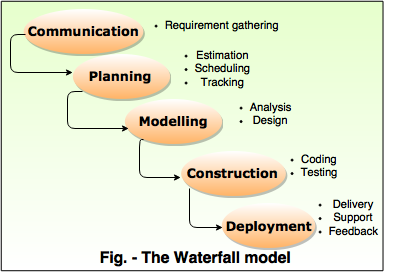
Image Source: http://www.tutorialride.com/software-testing/software-development-process-models.htm
Looking at the above illustration, you will notice that this model consists of 5 steps. These are: –
i) Communication: This is an interaction to exchange information between you as a developer and your client.
ii) Planning: This phase looks into chalking out a comprehensive estimate for your project along with the scheduling pattern to complete your project.
iii) Modeling: This stage looks into the complete requirement analysis along with the design of the project taking the shape of an algorithm or a flowchart.
iv) Construction: Using an appropriate coding language, the construction stage involves not only coding but also testing. After the code is generated, it is tested to ascertain whether the flow of code matches the required specifications. It is through detailed testing that you will know whether your project comes up with the desired outcome.
v) Deployment: The final stage of the Waterfall Model is to deploy the tested deliverable at your client’s site while collating feedback about its performance. Depending on the changes demanded by your client, you will be making changes to the code to fit in additional functionalities as an improvement to the quality of your code.
2. Agile Model – The Most Patronized Process Model
As a perfect alternative to the waterfall model, coders are patronizing the Agile Model. Identified as the most widely used process model, Agile which facilitates frequent reassessments and changes in software plan and design comes as a top choice. “Customer satisfaction at every stage of the project” is the mantra behind this model which breaks down the entire software product into individual iterations.
Every iteration involves the participation of cross-functional teams associated with the processes of planning, requirement gathering, analysis, project design, coding, unit testing and finally acceptance testing. Enabling your customer to witness a demo of every new feature, it is through the Agile model that you can garner the goodwill of a satisfied client.
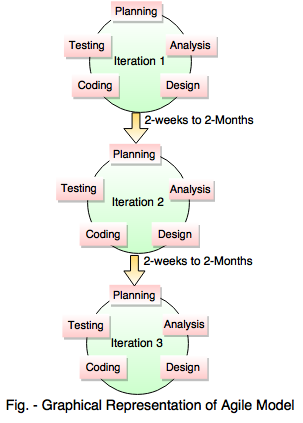
Image Source: http://www.tutorialride.com/software-testing/agile-model.htm
3. “V” Model – “V” For Verification and Validation
Moving on to the third model in the list, some companies employ the “V” model which superimposes the job roles of a developer and a tester. Mapping eachother’s roles, this model promises the parallel running of software development and testing.
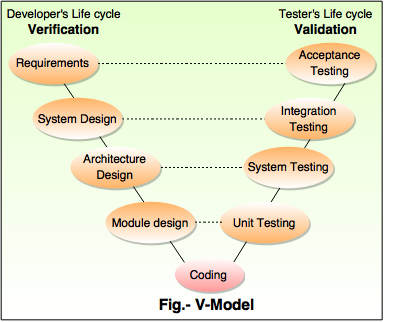
Image Source: http://www.tutorialride.com/software-testing/software-development-process-models.htm
The above graphical representation perfectly describes the superimposing of a developer’s and tester’s lifecycle as specified by the V Model.
Speaking of the verification phase, this stage tries to answer questions about whether you are building the product in the right manner and whether your software meets the most recent specifications of your client.
Validation is concerned with two important criteria. The first one delves into the details about building the right product and the second is majorly concerned about checking whether the software’s performance is in tune with the specified needs of your client.
4. Incremental Model
Combining the elements of the Waterfall Model, the Incremental Model uses these elements in a repetitive (iterative) manner. The first increment is the actual product. With each increment, you as a developer will be building the code so as to modify the product according to what your client wants. The following increments incorporate the changes suggested by your client as an addition to the earlier increment. This goes on until the final product is ready to be released.
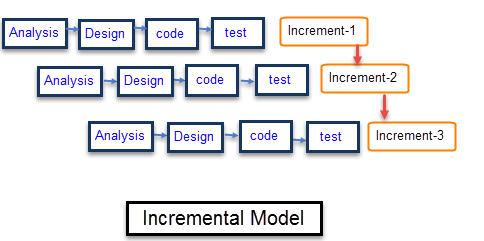
Image Source:
https://cdn.guru99.com/images/6-2015/052615_1049_WhatisIncre2.png
Let us now look at the different phases of Incremental Model: –
a) Communication: Before you start developing software code, you initiate an exchange of information between you and your client.
b) Planning: You then arrive at a complete estimate of your project while scheduling the various stages of software development.
c) Modeling: This stage involves the complete requirement analysis, followed by attempting to design the project through algorithms and flowcharts.
d) Construction: As the name suggests, the construction stage looks into two aspects of generating code and testing the same. The code is generated using a suitable programming language and the testing stage ensures whether the flow of code is right or faulty. Testing is also performed to check whether the code produces the desired output.
e) Deployment: Making changes to the code according to the feedback offered by your client, it is during this stage of deployment that you will add new capabilities to the existing code. The final product is then presented to your client as a high-quality and robust software code.
5. RAD Model – The Abbreviation of Rapid Application Development Model
Identified as a type of Incremental Model, RAD model facilitates the breaking down of the project into smaller projects by the simultaneous building of components and functions. Each mini project is coded and delivered to the client after assembling it into a prototype. This model thus helps your client to offer constructive feedback regarding the project and its deliverables.

Image Source: http://www.tutorialride.com/software-testing/rad-model.htm
This model consists of various phases, all of which are enlisted below: –
• Business Modeling: – This is the state at which information is exchanged between the various business entities of the project.
• Data Modeling: – The processed information of the business modeling stage comes handy at this stage when the same is used to define data objects that are required by your client.
• Process Modeling: – After data objects are defined, process modeling comes into the picture to ensure that these objects become the instruments to achieve certain pre-defined objectives.
• Application Generation: – This stage is all about employing automated tools which help in the conversion of the earlier process model into a software code.
• Testing and Turnover: – This is the ultimate stage when new components are tested along with all the interfaces.
6. Spiral Model – A Combination of Iterative and Waterfall Models
Tagged as a union of waterfall and iterative models, the Spiral Model begins with a small set of requirements which are compared at every stage of software development to ensure their perfect matching. Every phase of a spiral model is initiated according to the design goal of your client, ending with a client review.
The word Spiral is apt for this model as the team of software developers working on a project add functionalities to the requirements in the pattern of broadening spirals till such time the entire application is ready to move on to the production phase.
Apt for large and medium-risk projects, a spiral model can be employed to projects which demand frequent releases. Best suited to projects which have vague or complex specifications, this model helps developers make changes to the code at any point of time.
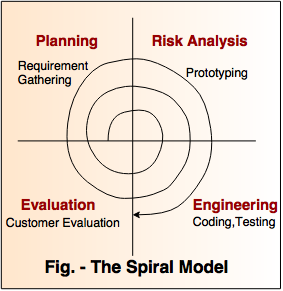
Image Source: https://www.guru99.com/what-is-spiral-model-when-to-use-advantages-disadvantages.html
The Spiral Model comprises of four stages: –
1. Planning: – This stage delves into estimates of cost, resources and schedules that would be iterative in nature. Planning also involves the overall understanding of the system requirements between you as a system analyst and your client.
2. Risk Analysis: – The second phase focuses on identifying potential threats through the formulation of a risk mitigation strategy which is jotted and finalized.
3. Software Engineering: – The 3rd stage concerns testing, coding and deploying software at the client’s site.
4. Evaluation: – Your client steps in, and evaluates your software keeping in mind the risks of cost overrunning and missing delivery schedules.
7. Iterative Model
In common parlance, the word iterative means repetitive. Same is the case with software design and development. In this model, the mammoth application that should be developed is separated into smaller modules of software. Each and every module becomes the subject for further improvements when it goes through all the phases of software development, viz. requirement analysis, design, implementation and code testing. All these phases are repeated in a chronological order till such time the final product is acceptable.
Below is the rundown of the different stages in the Iterative Model of Software Development: –
i) Requirement Phase: – The first stage involves the collection and analysis software requirements. The final specification of requirements is the document that moves to the next stage.
ii) Design Phase: – In accordance with the requirement specification document, you as a developer will then chalk out software design requirements while simultaneously creating a new or updated design.
iii) Implementation and Test Phase: – This is the stage which overlooks the coding and testing activities.
iv) Evaluation: – As the name suggests, it is during the evaluation stage that your software is appraised whether it is in line with the current requirements. If need arises, this stage helps you modify or add specs desired by your client.
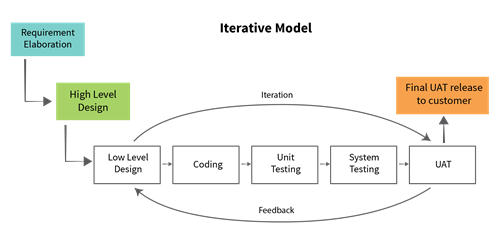
Image Source: https://www.evry.com/in/what-we-do/services/application-development-and-management/development-methodology/iterative-model/
8. Prototype Model
In line with its very name, a Prototype Model involves the designing of a primary form of the code by not going into the depths of detailed input and output features. Tagged as a software working model with a narrow functionality, this model helps to generate quick working programs.
Creating a prototype that can be discarded, coders who follow this model can better understand their client’s requirements. The prototype once displayed to your client allows him to get the “exact feel” of the system. Ideal for large and complicated projects, this model finds its place in systems, which do not call for a manual process to specify project requirements.
Below is the flowchart which describes the various stages of a Prototype Model.
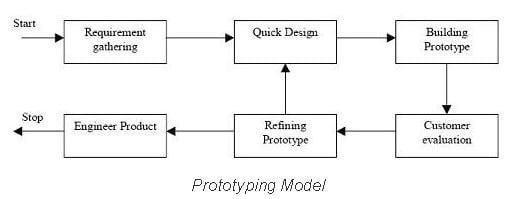
Image Source: http://istqbexamcertification.com/what-is-prototype-model-advantages-disadvantages-and-when-to-use-it/
9. Big-Bang Model
Typically meant to churn out small projects, a Big-Bang Model is a simple model that does not follow any rigid process. Not calling for any formal development patterns, this model can be executed with minimal planning. Taking into cognizance the time, budget and human effort that are needed to complete the project, the final outcome is the emergence of a software code that may or may not meet the requirements of your client.
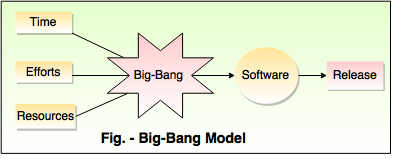
Image Source: http://www.tutorialride.com/software-testing/software-development-process-models.htm
10. Code and Fix Model
Seen as an earlier stage to the Big-Bang Model, the Code and Fix model focuses on identifying the product that should be tested before it is released into the market. This model calls for developers and testers who work in unison with each other.
While a team of testers attempt to find bugs, these bugs then reach the table of the developer who then codes again so as to fix the bugs. Requiring very less project planning, this model is best suited for small projects. However, this model does not guarantee a high-quality product since a lot of ambiguity exists about the final outcome and the timing of its release.
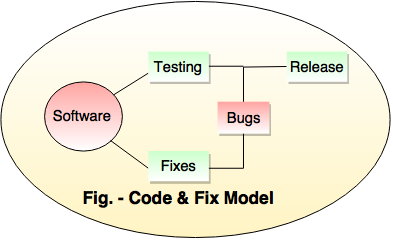
Image Source: http://www.tutorialride.com/software-testing/software-development-process-models.htm
Wrapping It Up: –
After enlisting all the various SDPMs that are currently in vogue, it makes sense to involve the end users of your software so that you can deliver a robust product to their utmost satisfaction. Requesting for the participation of your users will come as an intelligent move to make the right choice of a process model.


